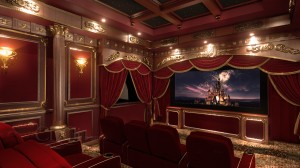This ornate theater harks back to the Golden Age of cinema, but with a healthy infusion of today’s top technologies.Judging from the pictures on these pages, the average Joe might conclude that this elaborate theater is over the top. But he would be forgetting that the traditional Hollywood movie palaces that inspired it were born during a time when the only limits to the amount of decadence and glamour that could be infused into such a palatial cinematic escape were the confines of the imagination. Back then, Hollywood went for the gusto, creating movie environments complete with gilded powder rooms, hand-carved balustrades, intricate ceilings, laboriously decorated prosceniums, and lavish box offices.
In the theater if nowhere else, homeowners can recapture that magic and push the boundaries of design. While one might not put red velvet curtains with gold tassels in the living room, they are entirely appropriate in the home theater.
When it comes down to it, under no circumstances can a home theater be deemed over the top if it harks back to the Golden Age of Hollywood—the days of Cary Grant and Humphrey Bogart, of Jean Harlow and Rita Hayworth. And that’s exactly what this home theater does with its on-point opulence. According to Bennett Bowman, project designer and sales associate at home technology professional firm Wilshire Home Entertainment, the homeowners continually encouraged him and home theater interiors contractor CDGi to “make a dramatic statement.”
But while this 400-square-foot, $400,000 room has the look and feel of a bygone movie palace, it is hardly old fashioned, thanks to its state-of-the-art technology. Wilshire chose a top-notch video system, for example, specifying a Runco VX22D projector with anamorphic lens shining on a Gorgeous Stewart Cinecurve 2.35:1 screen. “It wasn’t feasible to mount the projector on a lift or hide it in another room,” says Bowman. “In general, we are seeing fewer projector lifts in the home, which means a lot less shaking and a more stable image over time.”
The projector is the only piece of equipment you’ll see in the room, because the homeowners wanted it all to remain invisible to maintain the magnificent 1920s interior and suspension of disbelief. Wilshire concealed the system’s seven speakers and four subwoofers, with components hidden below the screen behind acoustical panels in the cowling.
One of the homeowners’ favorite features is the theater’s ease of operation. “A system should be as easy to use as an ATM machine,” says Bowman. “No one is taught how to use an ATM, but are led through the process with prompts.” That level of simplicity is echoed in this system thanks to intuitive URC remote controls. “The owners’ kids had the remote figured out before we even had a chance to show anyone how to use it … and we have yet to receive a service call.”
That, along with the theater’s interior design and performance, go a long way toward ensuring the residents’ ongoing satisfaction with the way the space turned out. The fact that the owners aligned themselves with a home technology professional and a design firm that could take their vision and run with it helped them achieve the dramatic statement they wanted without constraint, imbuing a healthy dose of Old Hollywood glamour into every detail.
Getting the Glamorous Look Emily Firtel, designer, CDGi
Like other manufacturers working with trusted dealers, CDGi (Cinema Design Group International) distributes custom home theater design packages to its network all over the United States and across the globe. From start to finish, CDGi provides the dealer design services, production and construction documents, lighting and electrical schemes and more, offering a total design and acoustic solution to the high-end AV community, while allowing the home tech pro to interface directly with the client.
This particular project, spearheaded by CDGi designer Emily Firtel with help from color coordinator Nancy Galea, was 100-percent custom. “The homeowners love gold and red, so we took that instruction and marched with it, coming up with something very elegant with tons of gold appliqué,” says Firtel. Firtel was an interior designer in South Africa before coming to Florida and getting a job with CDGi, who was looking for a fresh designer to bring all their projects in-house. Under the tutelage of Carey Schaffer, founder and VP of CDGi, Firtel learned everything she needed to know about navigating the world of tech-heavy interior design. “What the homeowner gets with us versus what they might get with a traditional interior designer is absolute peace of mind,” says Firtel. “The fact that we’ve been doing this for so long, that we specialize in this, means that we know exactly what our AV partners are going to encounter. We know where the wires go; we know how to construct a theater with proper sound containment and acoustics; we know what materials work best.”
Firtel helped design the speaker cowl in the front of the room, which contains four racks: two with hinged panels that the owners can open, and two that power the room and don’t need to be accessed as often.Everything that CDGi designed was manufactured at its facility in Florida to ensure a perfect fit, then shipped to the site.
The chairs, designed by First Impressions Theme Theatres, are motorized recliners and include the homeowners’ family crest and illuminated lion heads at the end of the armrests. Ceiling stars fade and brighten with the push of a button.

